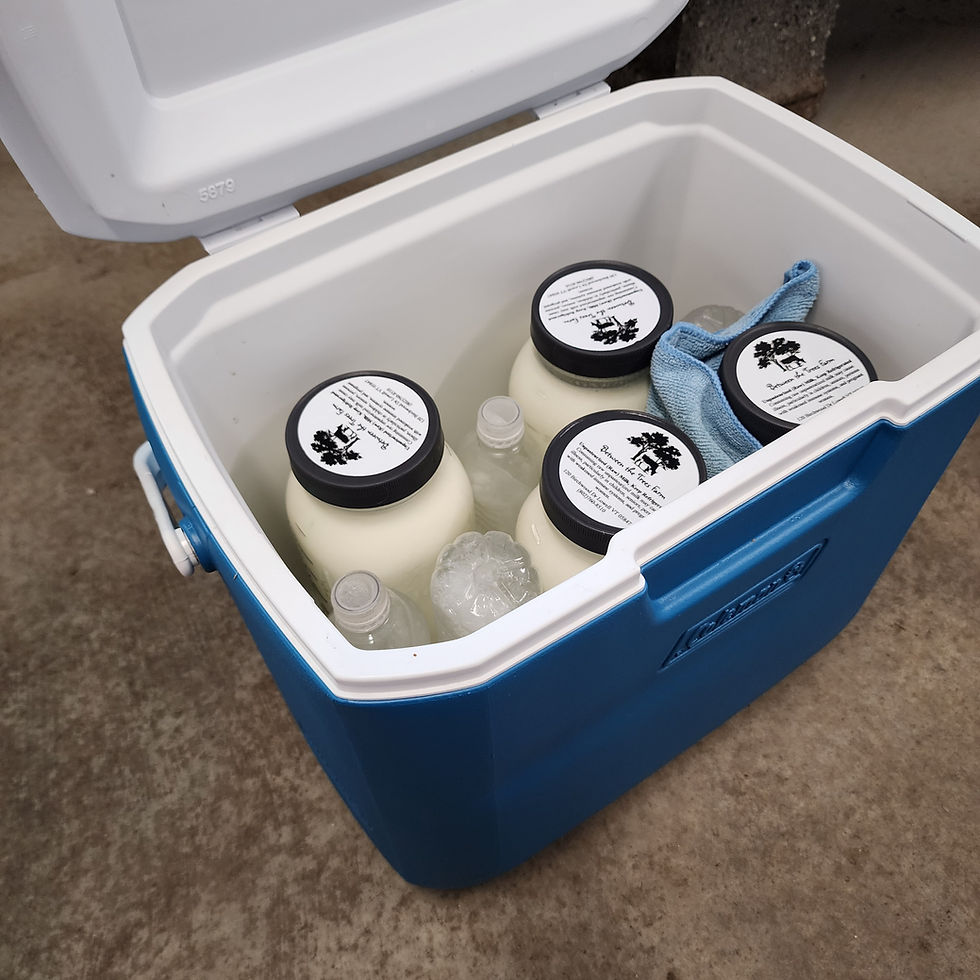Do These 3 Things to Bring Your Raw Milk Home Safely
- Hilary Elmer
- Jul 12, 2024
- 4 min read
Updated: Jun 24
For devoted grass fed raw milk enthusiasts, picking up your weekly milk is super exciting.
It's like bringing home liquid gold.
Nothing is more disappointing than having a glass jar break during transport and losing that precious milk. Spilled raw milk IS something to cry over.
And then you have to replace the jar.
Also, to ensure that your milk is as safe when you get home with it as it was when it left the farm, and to help it enjoy its longest possible shelf life, it's important to maintain the cold-chain. It should remain under 40F from the time you pick it up till you put it in your fridge.
Milk that has been kept cold tastes better than milk that has had warm spells.
Here are a few easy things you can do to keep your jars of milk safe and cold while transporting them.
1. Bring a chilled cooler.
Having a cooler both enables you to keep the milk below 40F on a hot summer day, and it also provides a place to keep the jars from rolling around and clanging against each other.
I bend over backwards to produce very clean milk with low bacteria counts, but all that hard work can be undone if the milk gets warm on the ride home. When the temperature of the milk rises above 40F, bacteria begin to multiply. When kept cold consistently, bacteria counts stay low and my milk can easily last for two weeks, but the warmer it gets in your car, the more likely it is to go bad before you have used it up.
If you don't already have a cooler to use for transporting milk, I recommend two options: a 30 quart Coleman cooler, (available for about $40) or an insulated backpack cooler (available for around $50). I prefer coolers that are fitted to the number of jars you put in them, because there is less chance of them rolling around, but of course you can use a large cooler if that's what you have.

The 30 quart cooler holds up to 6 half gallon jars, although I feel more comfortable putting only 4 into it. That leaves plenty of room for padding and ice bottles.
If you get 4 or less jars at a time and you want a smaller cooler instead, just verify before you buy that its interior height is at least 10 inches to accommodate the height of the jars.
For 3 or less jars, an insulated backpack is a great option. I have a backpack by Nevo Rhino, the 54-can size. It does a great job of transporting a smaller number of jars and keeping them cold with plenty of ice bottles. I like slinging it over my shoulders rather than carrying a big heavy cooler in front of me.

Another option is an insulated shopping bag, especially if you don't have a long ride home.
In a pinch, a cardboard box would work, but be sure you really pay attention to the next two points to make up for the lack of insulation. A box prevents jars rolling around, at least, and helps provide structure to hold the padding and ice close to the jars.
2. Pad your jars!
Glass jars are great because they don't add to the waste stream, and they don't impart chemicals to your pristine raw milk. But they will break if you aren't careful. Nobody wants to lose precious grass fed milk due to breakage, nobody wants to have to clean up glass shards, and nobody wants to have to pay to replace broken jars.
If you hear the glass clanging, that means it is in danger of breaking. Your goal should be to pad them sufficiently so that they never hit anything or make telltale noise.
There's no rocket science here. Just pad hand towels or something similar between each jar so they aren't touching each other, and to prevent them from falling and rattling around as you drive over bumpy roads.
Padding can also make up for lack of insulation, to a degree, if you are using a box rather than a cooler. You could lay a towel over the top to act as a lid to keep the cold in.
3. Bring ice.
If you put cold milk in a warm cooler, the milk is going to warm up. The cooler must be chilled to keep cold milk cold. This is particularly important in hot summer weather.
Just toss some ice into the cooler before you leave for your pick up, and it will be cool by the time you get there.
If you want to go the extra mile to really keep your milk cold, the best way is to have refrigerator-cold water poured into the cooler, along with the ice. The cold water will conduct the cold from the ice directly to the glass jars better than dry air. This is what the state tells me as a raw milk producer to do when I transport milk, because it works the best to keep milk under 40F.
My preferred form of ice is frozen water bottles. I find them convenient to use and refreeze. You can use loose ice cubes or blue ice, if you prefer. The important thing is to just have some form of ice.
If you love your raw milk, it makes sense to care of it as you bring it home so it is the safest, best tasting, and longest lasting it can be.






Comments